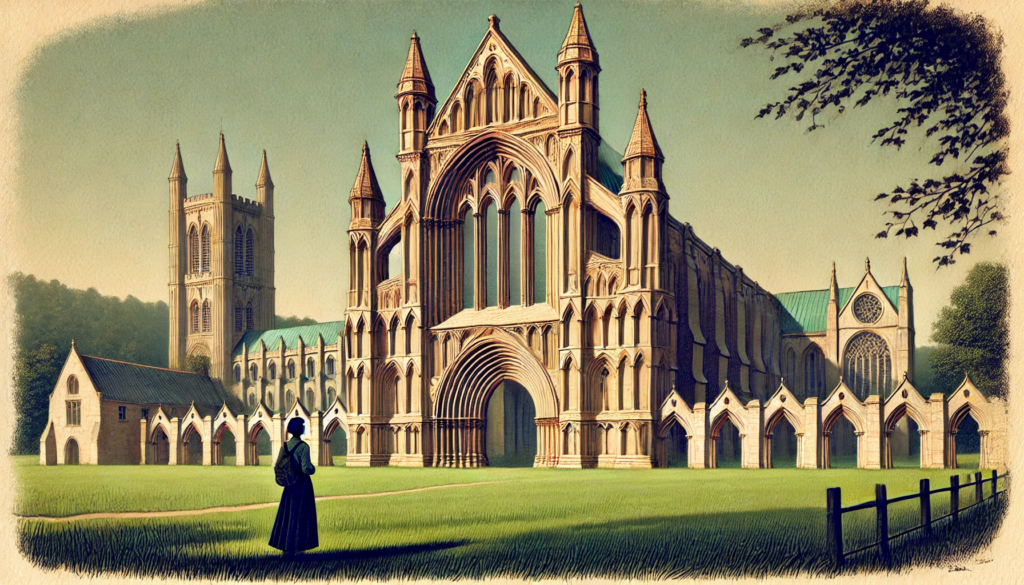ChatGPT:
St Albans, England: Origin, History, and Development
Location and Overview
St Albans is a historic city located in Hertfordshire, England, approximately 20 miles (32 km) north of London. Known for its rich history, St Albans is celebrated for its Roman heritage, medieval architecture, and vibrant modern culture. The city takes its name from Saint Alban, the first recorded Christian martyr in Britain.
Origins and Early History
Roman Verulamium
St Albans originated as the Roman settlement of Verulamium, established around 50 CE. It was one of the largest towns in Roman Britain and served as an important trading and administrative center. The remains of Verulamium include well-preserved mosaics, a Roman theatre, and remnants of the city walls, which are still visible today.
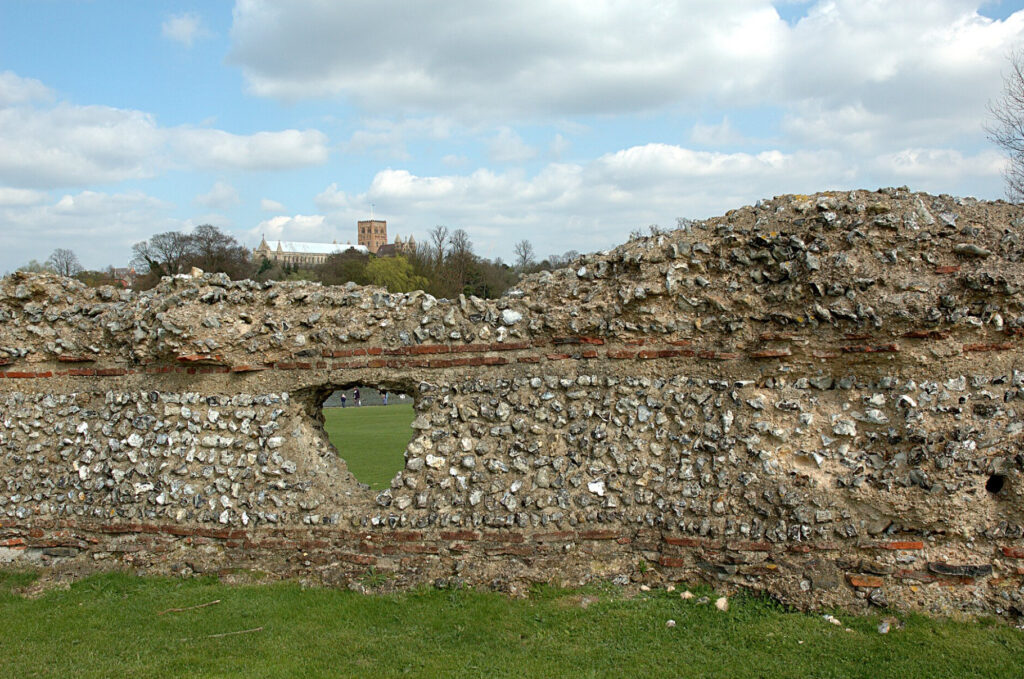
St Alban’s Martyrdom
The city is named after Saint Alban, a local resident believed to have been executed during Roman persecution of Christians in the 3rd or 4th century. Alban is said to have sheltered a Christian priest, adopted his faith, and was executed in his place. His martyrdom became a cornerstone of early British Christianity.
Medieval St Albans
St Albans Abbey
In the 8th century, Offa, King of Mercia, founded a Benedictine monastery on the site of St Alban’s martyrdom. This evolved into the St Albans Abbey, which became a major religious center and a site of pilgrimage in medieval England. The abbey played a pivotal role in the spiritual and political life of the nation.
Market Town
By the Middle Ages, St Albans developed into a prosperous market town, benefiting from its strategic location on the ancient Roman road, Watling Street, and its proximity to London. The city’s markets and fairs attracted merchants and traders from across the region.
The Peasants’ Revolt (1381)
St Albans was involved in the Peasants’ Revolt, as local residents protested against the oppressive policies of the abbey. This highlighted tensions between the monastery’s authority and the townspeople.
Tudor and Stuart Eras
Dissolution of the Monasteries
During the reign of Henry VIII, the dissolution of monasteries in the 16th century saw the abbey stripped of much of its wealth and power. However, the abbey church survived and was later elevated to the status of a cathedral in 1877, becoming the focal point of the Diocese of St Albans.
Civil War and Decline
The English Civil War (1642–1651) saw some economic decline in St Albans, although its location on major routes meant it remained a significant stopping point for travelers.
Industrial Revolution and Modern Development
Victorian Growth
The arrival of the railway in the 19th century transformed St Albans, connecting it to London and encouraging population growth. The city became a commuter hub for those working in the capital, a role it still holds today.
Preservation of Heritage
Throughout the 20th century, St Albans embraced its historic roots while adapting to modern demands. Its Roman, medieval, and Tudor heritage has been carefully preserved, making it a popular destination for tourists.
Modern St Albans
Today, St Albans is a thriving city known for its cultural offerings, excellent schools, and quality of life. It boasts a mix of historical attractions, such as St Albans Cathedral and Verulamium Park, along with modern amenities like restaurants, theaters, and markets.
Key Historical Sites
1. St Albans Cathedral: One of the oldest sites of continuous Christian worship in Britain, featuring Norman and Gothic architecture.
2. Verulamium Museum: Showcasing artifacts from the Roman city, including mosaics and pottery.
3. Roman Theatre: The only visible Roman theatre in Britain, used for religious and entertainment purposes.
4. Clock Tower: A rare example of a medieval town belfry, built in the early 15th century.
Cultural and Economic Significance
St Albans’ proximity to London, coupled with its rich history and vibrant cultural scene, make it an attractive place for both residents and visitors. It is home to annual festivals, including the St Albans International Organ Festival, and its markets continue to thrive.
St Albans bridges the past and present, maintaining its historical charm while evolving as a modern city.
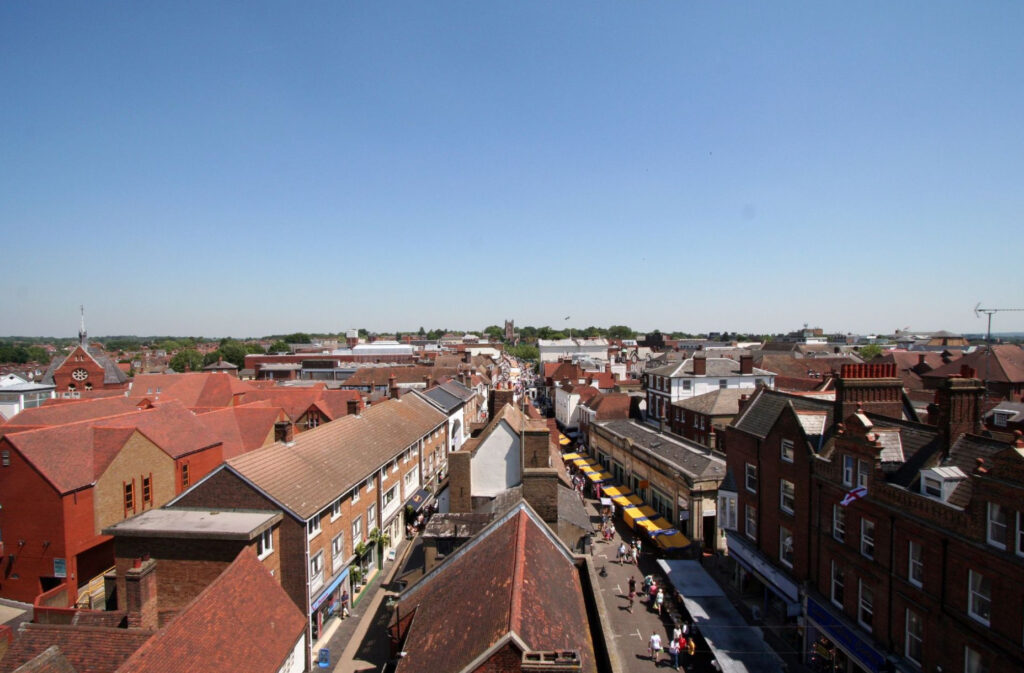
Watling Street: Origin, Function, and Route
Watling Street is one of the most famous ancient roads in Britain, with origins dating back to pre-Roman times. It served as a key route for trade, transport, and military movement and played a significant role in British history.
Origins
Pre-Roman Use
Watling Street began as a trackway created by ancient Britons, likely following natural contours and routes used by animals and early settlers. Its exact origins are unclear, but it was primarily a track for local tribes to travel, trade, and communicate.
Roman Development
When the Romans invaded Britain in 43 CE, they recognized the strategic importance of the route and developed it into a paved, engineered road. It became one of the primary arteries in the Roman road network in Britain. The Romans named it Iter II (Route 2) in their itineraries, but its later name “Watling Street” derives from the Old English term “Wæcelinga Stræt,” meaning “the street of the people of Wæcla.”
Function
1. Military Use
Watling Street was crucial for Roman military campaigns, facilitating the rapid movement of troops and supplies across the province of Britannia.
2. Trade and Commerce
The road connected major Roman towns and ports, enabling the transportation of goods, including pottery, grain, and wine.
3. Administrative and Social Connectivity
It linked Roman settlements, administrative centers, and outposts, fostering communication and governance throughout the province.
4. Post-Roman Era
In the Anglo-Saxon period, Watling Street remained significant as a boundary and transport route. It became a dividing line between Anglo-Saxon kingdoms (e.g., separating Danelaw from English territory after the Treaty of Wedmore in 878).
Route
The route of Watling Street can be divided into two main sections, both converging on London.
1. From Dover to Wroxeter (Via London)
• Dover: Starting point on the southeastern coast, a key Roman port connecting Britain to the continent.
• Canterbury: The route passed through this major Roman and later Christian center.
• Rochester: Crossed the River Medway here.
• London (Londinium): A major Roman city and administrative center.
• St Albans (Verulamium): An important Roman town along the way.
• Towcester (Lactodorum): A strategic stop in Northamptonshire.
• Wroxeter (Viroconium Cornoviorum): A Roman town in modern-day Shropshire, near the Welsh border.
2. From London to Chester
This section extended northwest:
• London: Starting point.
• St Albans: On its way to connect the Midlands and the northwest.
• Dunstable: A junction point where other Roman roads intersected.
• Chester (Deva Victrix): A major Roman military outpost.
Modern Legacy
1. Modern Roads
Much of Watling Street forms the basis of modern roads in Britain. Sections are part of the A2 (from London to Dover) and A5 (from London to Wroxeter and beyond).
2. Historical and Cultural Significance
It remains a symbol of Roman engineering and a reminder of the ancient connectivity that shaped Britain’s development.
3. Tourism
Key Roman sites along Watling Street, such as St Albans (Verulamium), Dover Castle, and Wroxeter Roman City, attract history enthusiasts.
Conclusion
Watling Street stands as one of the most enduring symbols of Britain’s Roman heritage. From its origins as a tribal path to its transformation into a sophisticated Roman road, it has played a central role in shaping the history, economy, and culture of Britain for centuries. Today, its remnants and alignment continue to be integral to the country’s infrastructure and historical identity.
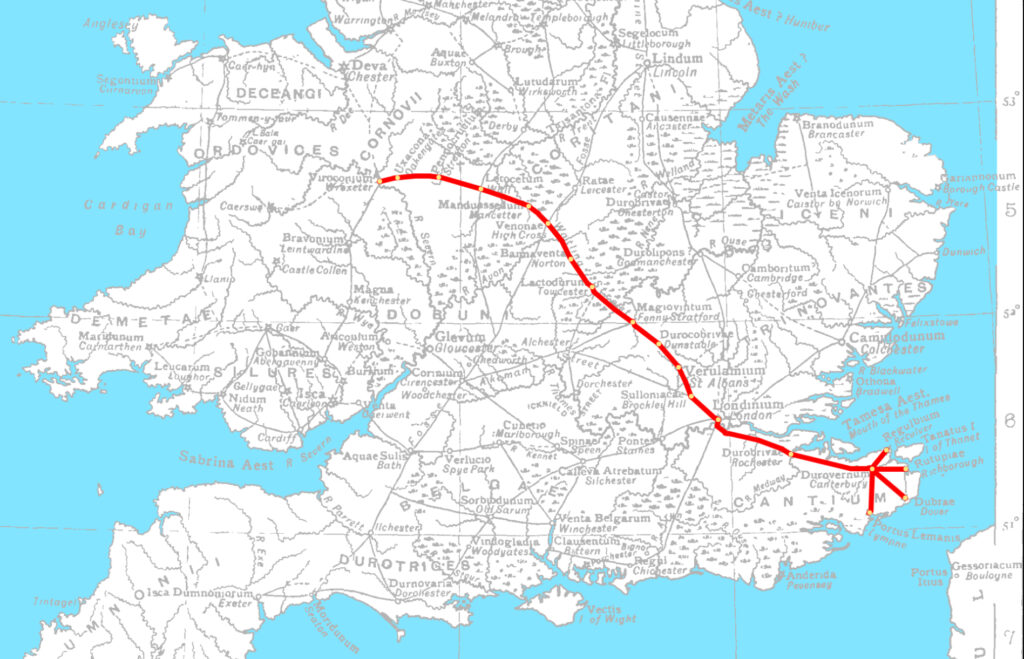
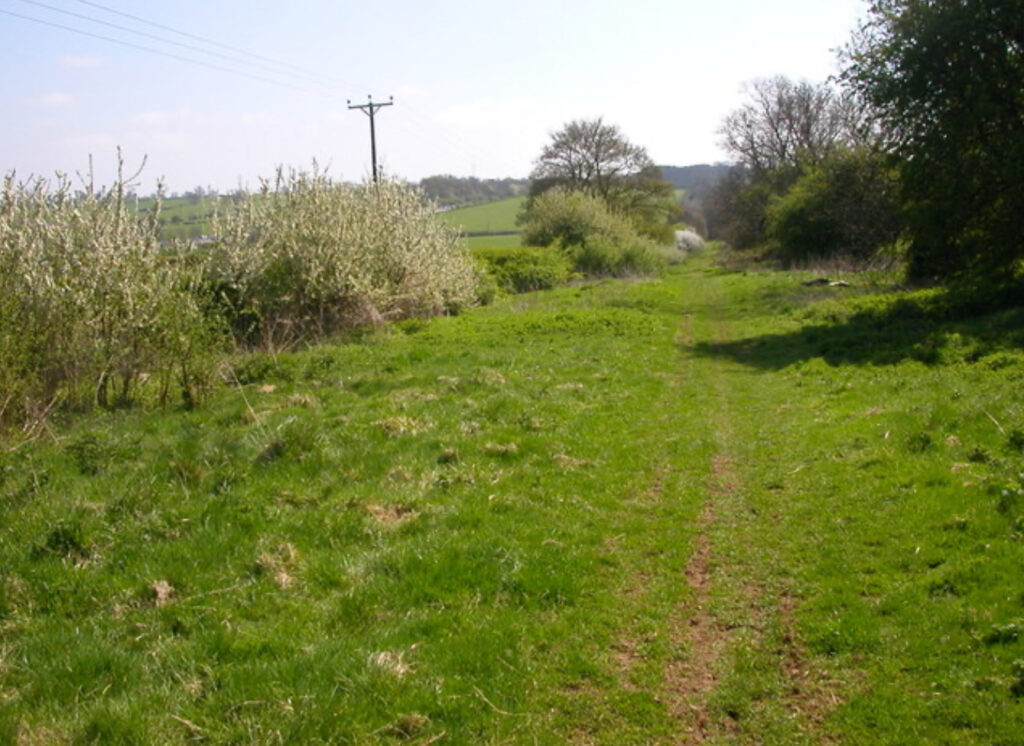
St Albans Cathedral: Origin and Architectural Features
St Albans Cathedral, officially known as the Cathedral and Abbey Church of St Alban, is one of the most historically significant and architecturally unique religious buildings in England. It is renowned as the oldest site of continuous Christian worship in the country.
Origin
Martyrdom of Saint Alban
The cathedral is dedicated to Saint Alban, the first recorded Christian martyr in Britain. Alban, a Roman citizen of Verulamium (modern St Albans), was executed around 250–300 CE for sheltering a Christian priest and converting to Christianity. He was beheaded on the hill where the cathedral now stands.
Early Foundations
• A shrine to Saint Alban was established shortly after his death, becoming a major pilgrimage site.
• In 793 CE, Offa, King of Mercia, founded a Benedictine monastery on the site, which grew in importance during the Middle Ages.
Medieval Development
• The abbey was rebuilt and expanded between the 11th and 13th centuries, evolving into a grand Norman and Gothic structure. It served as a powerful monastic center until the Dissolution of the Monasteries under Henry VIII in 1539.
• In 1877, the abbey was elevated to cathedral status, becoming the seat of the Bishop of St Albans.
Architectural Features
St Albans Cathedral reflects a blend of architectural styles due to its long history, constant evolution, and periods of restoration.
1. Norman (Romanesque) Architecture
• Nave: The cathedral boasts one of the longest naves in England (85 meters). Its rounded arches, massive columns, and thick walls are characteristic of Norman design.
• Materials: The building incorporates reused Roman bricks and tiles from Verulamium, evident in its distinctive red and cream coloring.
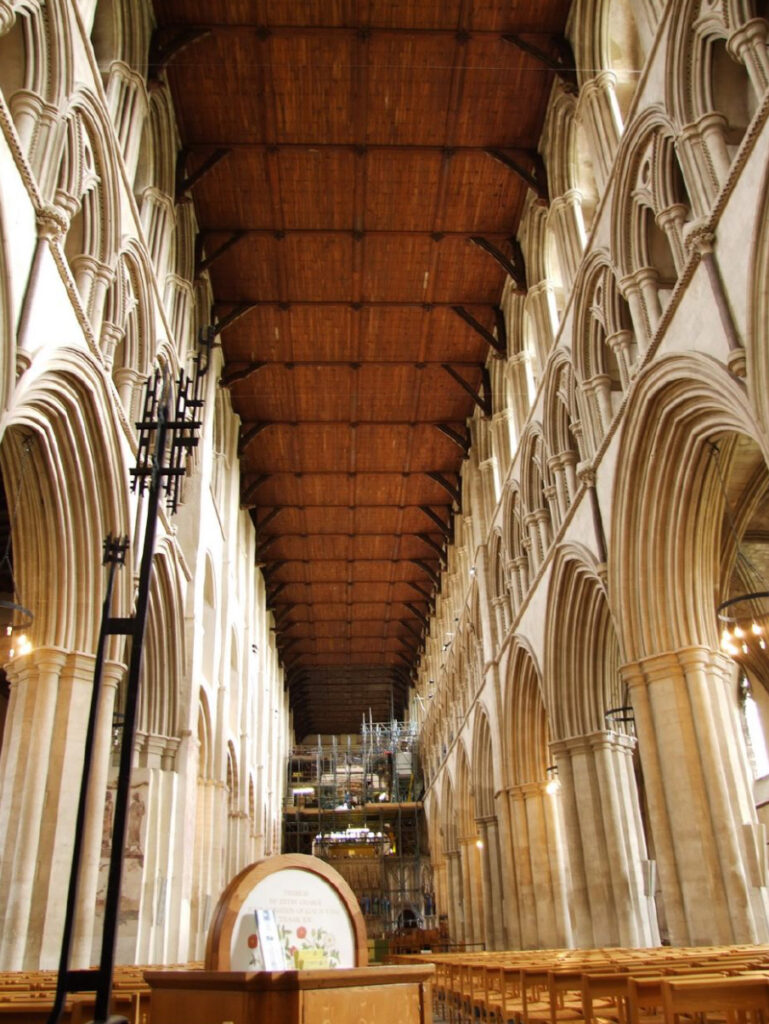
2. Gothic Additions
• Crossing Tower: The 11th-century Norman tower is unique as it is the only large, fully surviving Anglo-Norman crossing tower in England. Its robust design reflects early Gothic influences.
• West Front: Added in the late 19th century, the west front features intricate Gothic revival elements, including pointed arches and ornamental detailing.
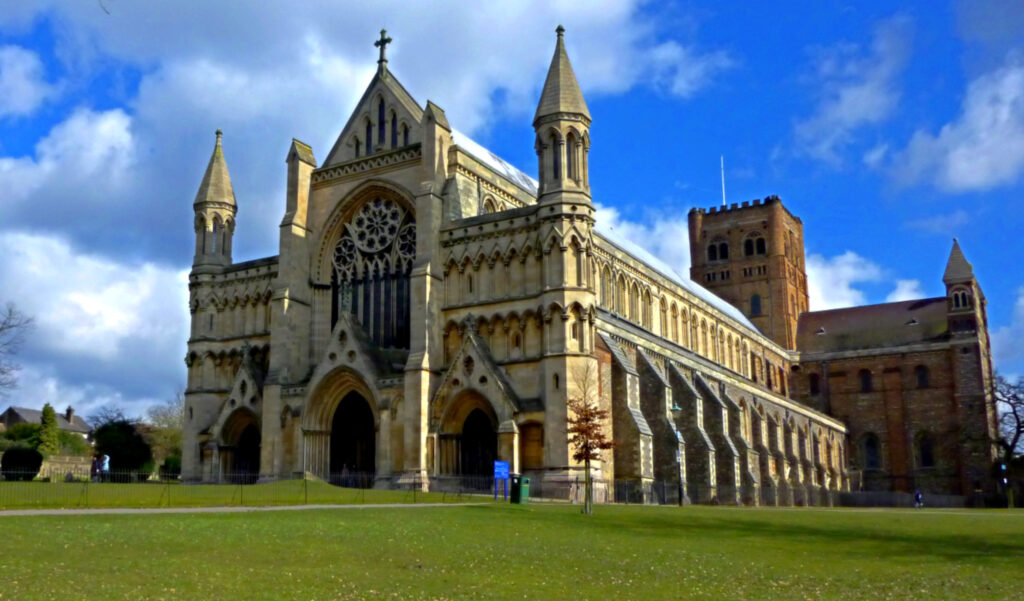
3. Medieval Wall Paintings
• The cathedral houses some of the finest surviving medieval wall paintings in England, dating from the 12th to 15th centuries. These depict biblical scenes, saints, and allegorical figures.
4. Shrine of Saint Alban
• The restored Shrine of Saint Alban is a centerpiece of the cathedral. Originally built in the 14th century, the shrine is a place of pilgrimage and features elaborate Gothic carvings.
5. Lady Chapel
• The Lady Chapel, added in the 13th century, is a stunning example of Early English Gothic architecture. Its soaring windows and slender columns create a sense of light and space.
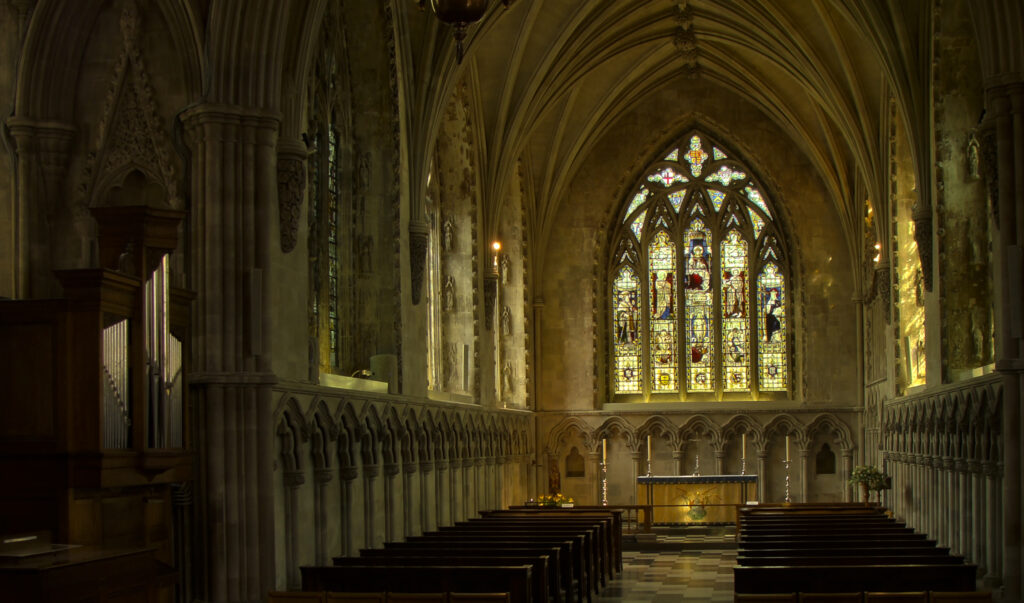
6. Unique Features
• Purbeck Marble: Used in several columns and decorative features, adding to the visual richness of the interiors.
• Ceiling Bosses: Carved and painted bosses adorn the wooden ceiling of the nave and choir, depicting biblical and symbolic imagery.
7. Victorian Restoration
• During the 19th century, Sir George Gilbert Scott led a major restoration project. While controversial at the time, it preserved the structure and added the striking west front in a Gothic Revival style.
Significance
• Pilgrimage Site: St Albans Cathedral remains an important pilgrimage site due to its association with Saint Alban.
• Cultural and Historical Heritage: The cathedral is a living record of English architectural styles and religious history, attracting visitors and scholars from around the world.
St Albans Cathedral is a testament to over a millennium of faith, history, and architectural innovation, standing as a beacon of heritage and spirituality in England.
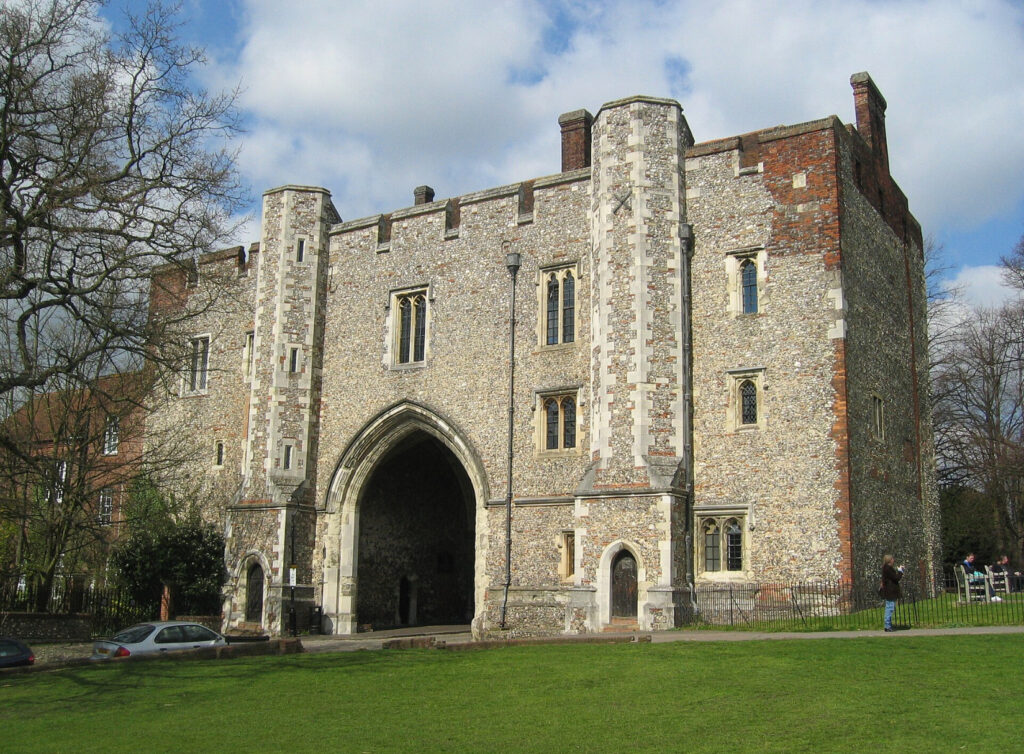
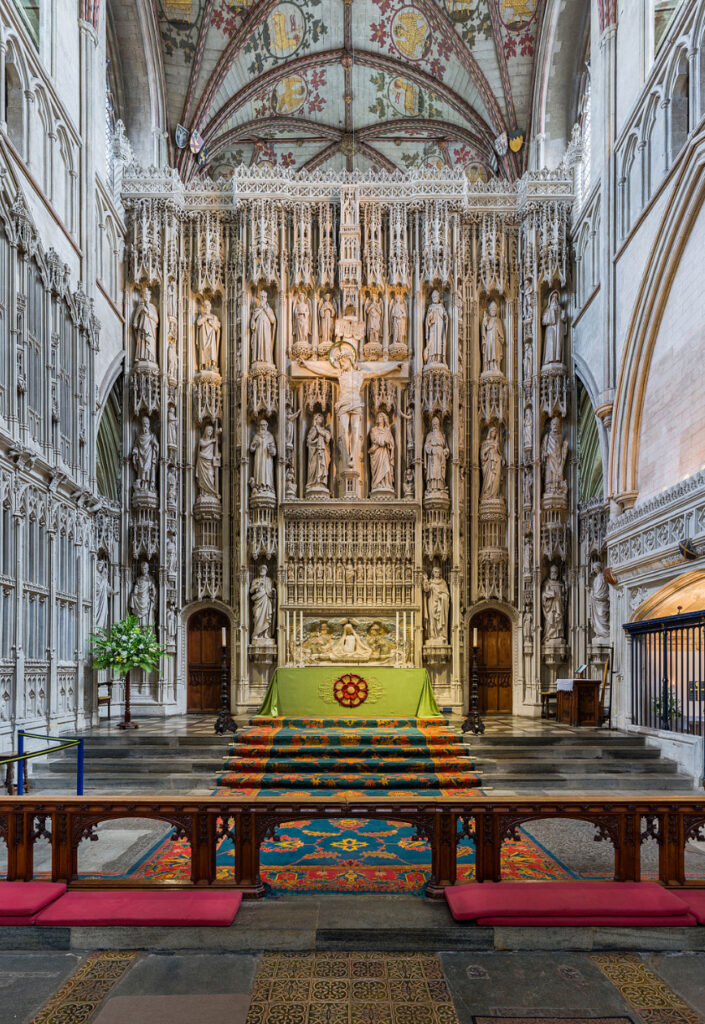
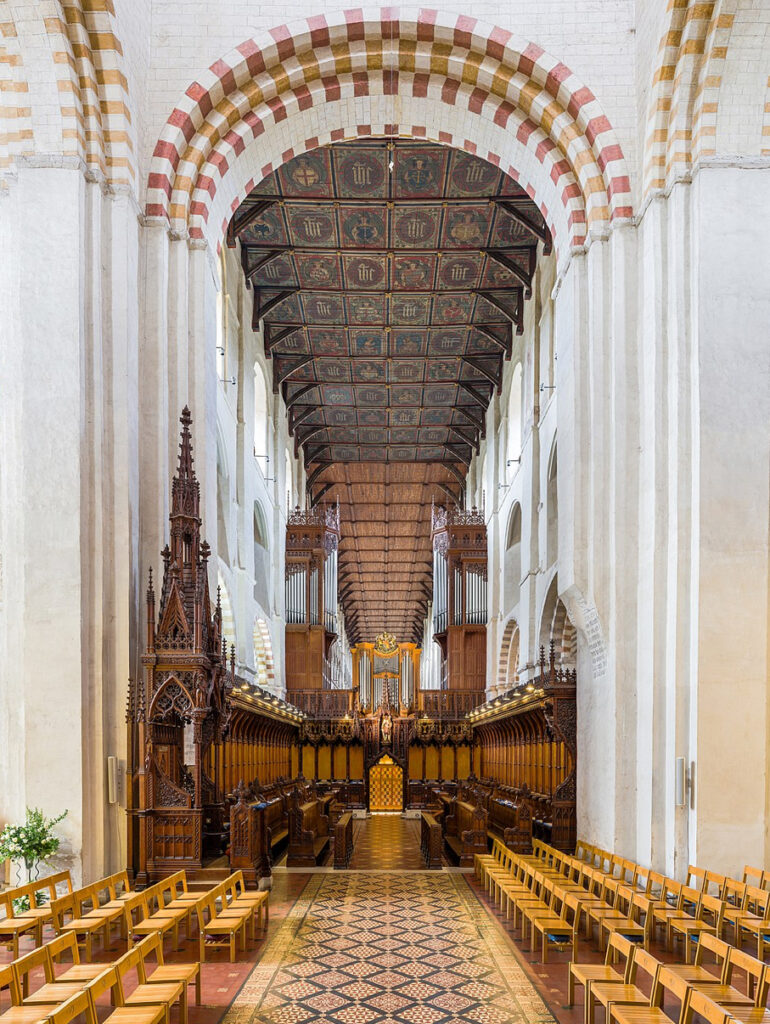
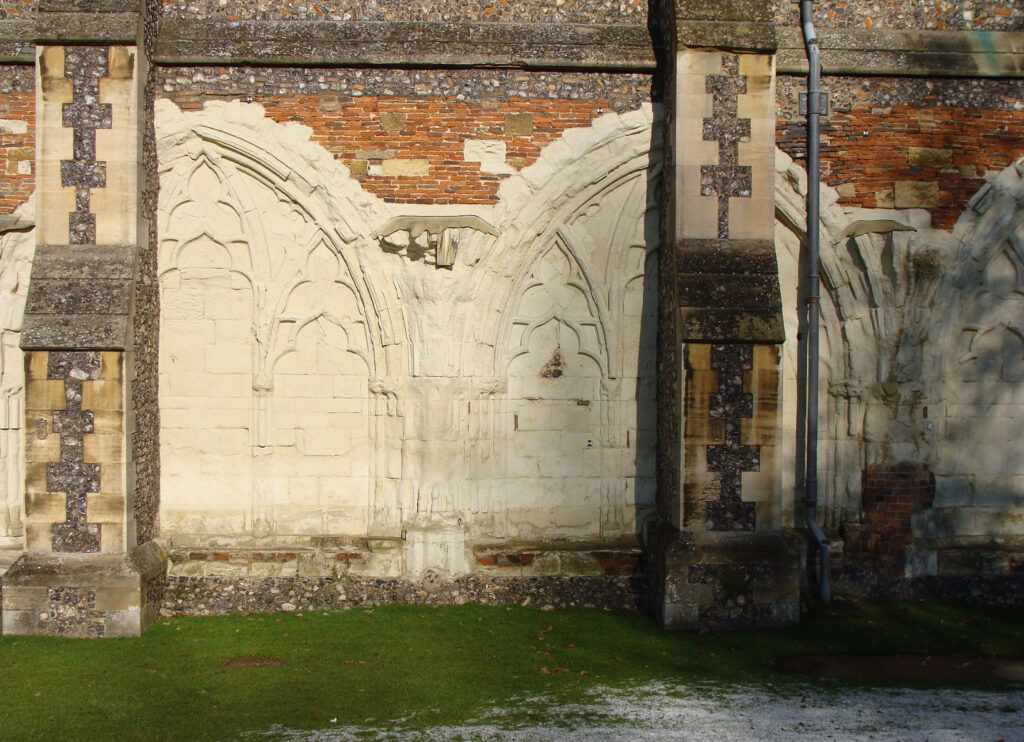
One-Day Itinerary for Visiting St Albans
This itinerary highlights St Albans’ historical charm and culinary delights, ensuring a fulfilling and immersive experience.
Morning
9:00 AM – Breakfast at The Pudding Stop
• Start your day at this award-winning café known for its fresh, homemade pastries and puddings. Try their legendary cinnamon buns or breakfast crumble paired with locally roasted coffee.
10:00 AM – St Albans Cathedral
• Visit St Albans Cathedral, the oldest continuous site of Christian worship in Britain. Marvel at its stunning mix of Norman and Gothic architecture, and don’t miss the shrine of Saint Alban and the medieval wall paintings.
11:30 AM – Verulamium Park and Museum
• Take a leisurely stroll through Verulamium Park, located on the site of the ancient Roman city. Visit the Verulamium Museum to explore Roman mosaics, coins, and artifacts. Nearby, see the remains of the Roman Theatre, the only visible one of its kind in Britain.
Afternoon
1:00 PM – Lunch at Ye Olde Fighting Cocks
• Enjoy lunch at one of England’s oldest pubs, located near Verulamium Park. The menu includes classic British dishes with a twist. Try the Hertfordshire beef pie or the beer-battered haddock, paired with a pint of local ale.
2:30 PM – Explore the Clock Tower and City Market
• Climb the Clock Tower, a rare medieval belfry offering panoramic views of the city. Then, wander through St Albans Market (Wednesdays and Saturdays), where you can sample locally produced cheeses, breads, and other delicacies.
3:30 PM – Afternoon Treat at Hatch Coffee
• Pause for a mid-afternoon break at Hatch, a local favorite. Savor their rich hot chocolate or a slice of Hertfordshire honey cake for a sweet indulgence.
Evening
4:30 PM – Walk Along Sopwell Nunnery Ruins
• Visit the Sopwell Nunnery Ruins, a peaceful and picturesque spot with medieval history, perfect for a quiet reflection or a short walk.
6:00 PM – Dinner at St Villa
• End your day with a fine dining experience at St Villa, a contemporary restaurant offering locally sourced dishes. Try their roast lamb with seasonal vegetables or the pan-seared duck breast, paired with a Hertfordshire wine.
8:00 PM – Optional Evening Walk
• If time permits, take a relaxing evening walk along the River Ver Trail, enjoying the tranquil surroundings and reflecting on your day.
This itinerary combines the rich history of St Albans with its vibrant food scene, providing a balanced mix of exploration, relaxation, and culinary enjoyment.
